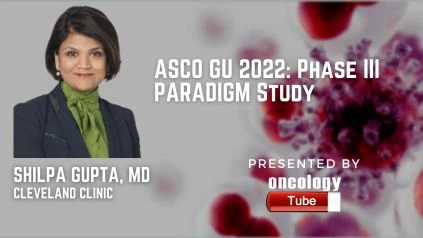Shilpa Gupta, MD, Director of the Genitourinary Medical Oncology at Taussig Cancer Institute and Co-Leader of the Genitourinary Oncology Program at Cleveland Clinic. In this video, she speaks about the ASCO GU 2022 Abstract – Disease management and frontline treatment of locally advanced or metastatic urothelial (la/mUC) carcinoma: The U.S. physician PARADIGM study.
Origins:
The therapy options for la/mUC are changing. There is a scarcity of data on current la/mUC therapy patterns. Using qualitative interviews, this study examined physician treatment decision-making and prescribing trends in the United States (QIs).
Methodologies:
First, published abstracts from January 2018 to March 2021 were reviewed using a targeted literature search (TLS). The TLS findings were then used to perform QIs with 15 US medical oncologists/urologists in July 2021. Physicians were asked to participate in a 60-minute, one-on-one phone interview. Physicians are required to be board-certified oncologists/urologists who have managed 1 la/mUC patients who had had first-line (1L) systemic therapy in the previous 6 months.
Outcomes:
Seven retrospective studies published in the United States indicated low usage of 1L systemic therapy, with 40 percent to 65 percent of la/mUC patients not being treated; substantial attrition rates were noted, with only 15 percent to 40 percent of 1L patients receiving second-line (2L) medication. The TLS only contained patient data from 2017 onwards, and it did not cover current systemic therapy patterns for newly licensed medications. Community oncologists (n = 8), academic oncologists (n = 4), and community urologists (n = 3) were among the QI respondents. In the previous six months, each physician saw an average of 23 la/mUC patients. According to doctors, around 75% of la/mUC patients are now receiving systemic therapy, with all oncologists recommending 1L immunotherapy (IO) maintenance to eligible patients (n = 10 prescribing avelumab for 90%). With the availability of IO and innovative medicines, 11 respondents (73%) believe that the proportion of systemic-treated patients has increased in recent years. Poor performance status (73 percent), old age (67 percent), patient preference (53 percent), and comorbidities were the top reasons for not recommending systemic therapy (47 percent ). According to physician reports, 41% of 1L regimens were carboplatin-based, 37% were cisplatin-based, 17% were single-agent IO, and 4% were nonplatinum chemotherapy. Renal function (100%), performance status (75%), neuropathy (75%), and age were the most important factors in deciding on a 1L regimen (50 percent ). Patients who were platinum ineligible or who declined chemotherapy were usually given IO. According to ten oncologists, 60 percent to 80 percent of 1L la/mUC patients were given a 2L treatment.
Observations:
Physicians reported greater treatment rates from the QIs than from the TLS; however, our physician sample was small, and the TLS only included patient data up to 2017, so it does not reflect current systemic treatment practices. Due to increasing treatment choices after 2017, the number of US la/mUC patients treated with/eligible for 1L systemic therapy has increased over time, including IO maintenance and subsequent lines. The next step in this research will be a quantitative survey of 150 medical oncologists.

